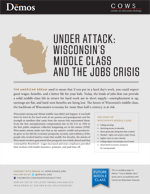The American Dream used to mean that if you put in a hard day's work, you could expect good wages, benefits, and a better life for your kids. Today, the kinds of jobs that can provide a solid middle-class life in return for hard work are in short supply—unemployment is up, earnings are flat, and hard-won benefits are being lost. The future of Wisconsin’s middle class, the backbone of Wisconsin’s economy for more than half a century, is at risk.
Wisconsin’s strong and vibrant middle class didn’t just happen. It was built brick by brick by the hard work of our parents and grandparents and the strength in numbers that came from the unions that represented them. From the first unemployment compensation law in the U.S. in 1932 to the first public employee collective bargaining act in the nation (1959), Wisconsin’s unions made sure that as our nation's wealth and productivity grew, so too did the economic prosperity, security, and resiliency of the people who worked hard to create that wealth. For decades, the unions of Wisconsin’s workers guaranteed that prosperity was widely shared and that communities flourished—wages increased and more employers provided their workers with health insurance, pensions, and paid time off.
Working alongside unions, the middle class grew more robust as public servants enacted government policies that supported homeownership and made a college education accessible to a new generation through affordable tuition and financial aid. Public servants also protected labor organizers, invested in public health, nearly eradicated the class of destitute elderly, and promoted infrastructure and local businesses.
But all of this is changing. Wisconsin has been caught in a long downward spiral that mirrors unfortunate national trends. Before the Great Recession even began, “construction and manufacturing were already on the decline, the job market was shrinking, and family incomes were falling” in Wisconsin.¹ And not only did the state then lose more than 250,000 jobs because of the Great Recession, but the economic effects of those lost jobs reverberated to all corners of the state, particularly the already-strained finances of the state government. We estimate that the jobs lost due to the recession have cost Madison over $445 million annually in lost sales and income tax revenues, on top of other revenue losses from the recession, putting thousands more middle-class jobs at risk. If the state’s unemployment rate were at pre-recession levels, those lost hundreds of millions would return to the state government’s coffers, and could be used to help thousands of young people attend college, maintain dozens of state parks, or hire, for example, as many as 4,000 teachers or 3,300 nurses.
Wisconsin workers only earn about $70 more per week than they did 30 years ago—despite having increased their productivity and educational qualifications to record levels. There’s also been a rapid decline in the number of employers who provide their workers with health insurance. Rising out-of-pocket costs and skimpy plans mean that a family illness can lead to substantial costs, medical debt, and bankruptcy. And as employers replace traditional pensions with 401(k)-type plans, middle-class workers can no longer count on a secure retirement. Most devastating, Wisconsin unemployment nearly doubled during the recession and of those who still had a job, 23 percent earned poverty wages ($10.46 per hour) or less in 2009.
Recent events gutting the longstanding ability of Wisconsin’s public sector employees to collectively bargain shows a fundamental misunderstanding of the economic importance of both public and private sector unionized workers as they have historically produced the most robust local economies, the healthiest families, and the most vibrant citizenries. Actions like these degrade labor standards for all and weaken the position of workers trying to earn a living under reasonable conditions and those advocating on their behalf.
This is, nevertheless, a time of hope as workers, unions, families, and citizens offer unremitting resistance to the destruction of workers’ rights and all that is public. Wisconsinites continue to demand that public servants recognize working class Americans as the heart of the economy. They have come together to protect their right to collectively bargain, occupied the capitol building, protested in the tens of thousands, and organized to recall some of the Republican senators who voted to eviscerate workers’ rights. Unions have over 150 years of political wisdom in Wisconsin politics and they know Gov. Walker is shortsighted at best and destroying the middle class at worst—they know that employment ends deficits; that tax cuts destroy hard-won social safety nets; that big corporations have abandoned local and state economies; and that the rich must pay their fair share if communities are to thrive.
Another bright spot is Wisconsinites’ particularly strong work ethic. Even under the current challenging conditions, they are significantly more likely to be in the labor force than adults in other states. Over 70 percent of adults in the state are working or looking for a job, higher than the national figure of 65 percent.² Although unionization is down, Wisconsin still has more than 400,000 union members, making the state the 14th most unionized workforce in the nation. The state has the highest share of its workforce employed in manufacturing, which traditionally provides stable, middle-class employment. Wisconsin’s workforce is also well educated with access to a wide range of vocational-based degrees available from public institutions. Wisconsin’s technical college system produces substantially more occupational associate degrees than other states, and produces stronger wages for the holders of those degrees.
With a strong vocational training system already in place in the state, a strong manufacturing sector, a solid union base, and the ongoing fostering of connections between stakeholders and employers who value and respect the rights of their workers, Wisconsin has all of the ingredients to be a model for how to protect and rejuvenate the American dream: a strong middle class built on good union jobs for a hard day’s work.

